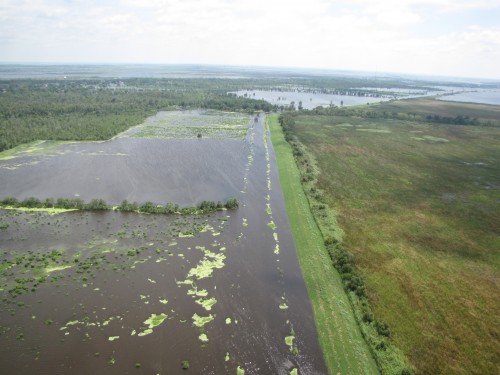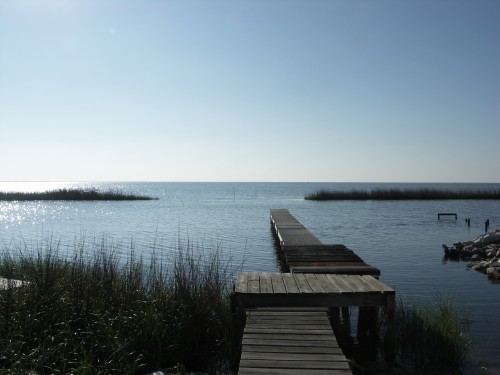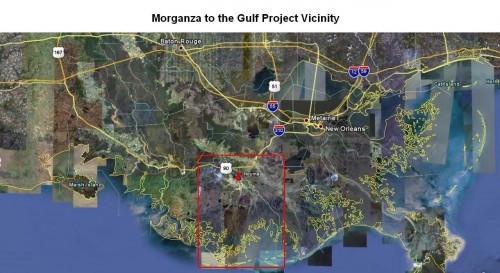
What is Morganza to the Gulf, anyway?
May 16, 2012
Why is our coast eroding so quickly?
May 16, 2012It’s called Morganza to the Gulf. The name might sound similar to Sherman’s March to the Sea in Georgia, but the Louisiana route has always been intended to protect inhabitants from the devastation of nature, rather than victimizing them to the ravages of man.
Nearly 80 years removed from its origins, and four years after the devastation of hurricanes Gustav and Ike brought the concept front-and-center in Terrebonne Parish, many people remain unsure how it began and what changed to form a 72-mile levee and floodgate system. A project designed to protect people and property from storm surges, while at the same time contributing to coastal land protection.
In the 1930s, construction began on a spillway along the Mississippi River at Morganza in Pointe Coupee Parish, nearly 40 miles northwest of Baton Rouge.
The Morganza spillway was completed in 1954 and intended to not only direct the Mississippi River along human-determined channels, but also protect the Atchafalaya Basin downstream to St. Mary and Terrebonne parishes from devastating floods as had been experienced in 1927.
Memorable flooding along the Atchafalaya River in 1973, that featured pounding rain in unison with the Morganza spillway being opened for the first time to protect larger populated areas in the state capitol and downstream to New Orleans, offered an indication that the intention of engineers a generation earlier was not infallible.
Twenty years later, Congress authorized a reconnaissance study for what was called the Morganza, La., to the Gulf of Mexico Hurricane Protection Project.
The study, which looked into what could be done to decrease flood and storm risks to southeastern Louisiana, began in 1992. Once completed, Congress authorized a flood protection feasibility study through the Energy and Water Development Appropriations Act of 1995.
Conducted by the U.S. Army Corps of Engineers, that feasibility study was completed in March 2002, with a findings letter forwarded to the secretary of the Army from the corps’ chief engineer. A supplement was added in July 2003.
Morganza to the Gulf was originally recognized as a triangular levee system intended to run from the Gulf of Mexico and along the Atchafalaya River on the west side. The eastern boundary was to follow Bayou Lafourche from the Gulf and meet the western reach at Morganza.
“The whole triangle between two ridges … included not only flood protection, but other things such as environmental protection,” said Terrebonne Levee and Conservation District Executive Director Reggie Dupre when explaining the Morganza system.
According to Dupre, who served as a state senator between 2006 and 2009, changes among administrations in Washington, D.C., and priorities for Congress resulted in the original Morganza project quietly fading away.
Local efforts kept the concept of a hurricane protection system, primarily for Terrebonne Parish and including a section of Lafourche Parish, alive. “The name Morganza to the Gulf never changed because that was the original corps name,” Dupre said. “Quite frankly, we never changed the name [and] the average citizen does not know the difference.”
The current Morganza-to-the-Gulf project was first proposed in 1992. The system of levee reaches and 12 floodgates are in line to make an 88-mile winding path from Bayou Lafourche in Lafourche Parish to Gibson in Terrebonne Parish once completed.
The initial reach between Bayou Terrebonne and the Humble Canal Floodgate south of Montegut was completed in 1996 with no federal assistance.
It was not until January 2009 that Gov. Bobby Jindal officially broke ground on Morganza to the Gulf and committed the state to 35 percent funding of the project. “For too long, the federal government has been sitting on their hands while our coasts remain vulnerable, ” Jindal said at that time. “The time for studies and waiting is over.”
The landmark Bush Canal floodgate, south of Chauvin at Bayou Terrebonne was completed ahead of schedule in 2011 and passed its first test on Sept. 3 and Sept. 4 by reducing surge water from Tropical Storm Lee. These and nine additional reaches are either finished or targeted to be complete in 2013 and 2014 at a total cost of $226 million.
Four additional reaches from Montegut to Gibson have yet to be funded and carry a projected price tag of $120 million.
Frustrated with the corps conducting study after modified study without delivering funds to help build the $886 million system, locals demonstrated their intention to get to work even without the original $310 million non-federal share for the project in hand. Levee board members decided the federal government could not be relied upon to act first.
In 2001, Terrebonne parish residents voted to pay a quarter-cent sales tax to fund a local match required for construction of the protection system. With that, work crews began building an interior levee system funded with local and state dollars to meet federal standards.
In addition to construction, tax revenue was also designated for maintenance and operation costs for the system once complete.
A series of hurricanes between 2005 and 2008 demonstrated the vulnerability of coastal Louisiana to the elements.
Congress did officially approve the current Morganza project in 2007, but legislative regulations decreed in 2011 made collecting federal funds by way of earmarks impossible.
Meanwhile, local contractors continue to build, reach-by-reach, a system the corps continues to study and backers wonder how to finance.
U.S. Army Corps of Engineers project manager Elaine Stark told the Terrebonne levee board in May 2011 that a federal financial report should be complete by the end of 2012.
However, substantial funding remains needed from the federal government, which was originally tagged to pay $576 million to complete the levee system.
In March, a Morganza Funding Task Force began meeting to discuss how to keep the project moving forward. Among their options is returning to taxpayers for increased local assistance.
According to some experts, Morganza to the Gulf could take another 35 years to complete. Without occasional reminders, the origins and efforts of developing this system are at risk of being forgotten much sooner.










